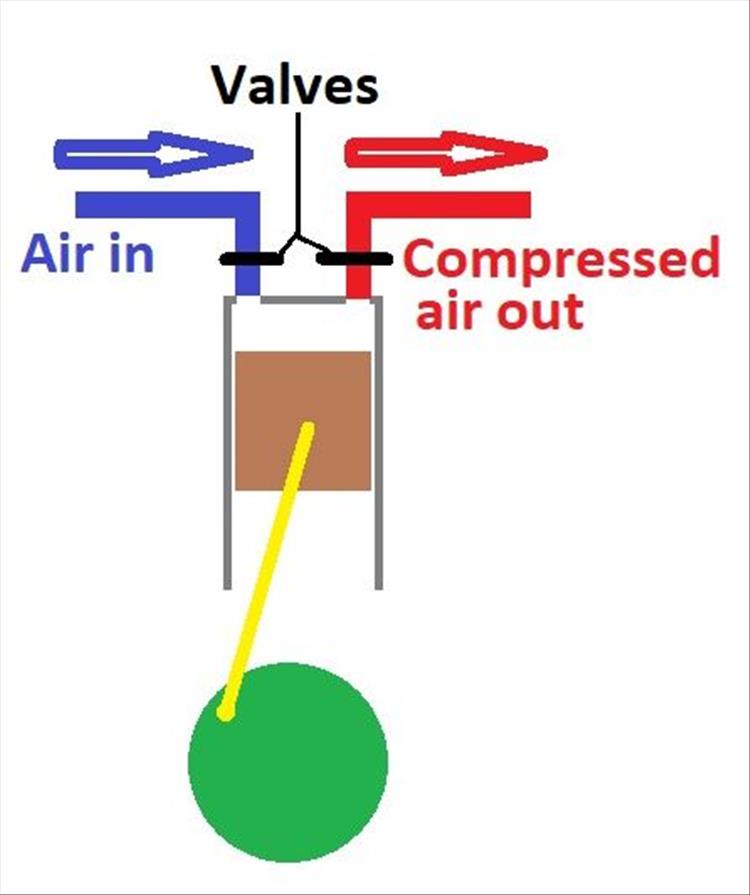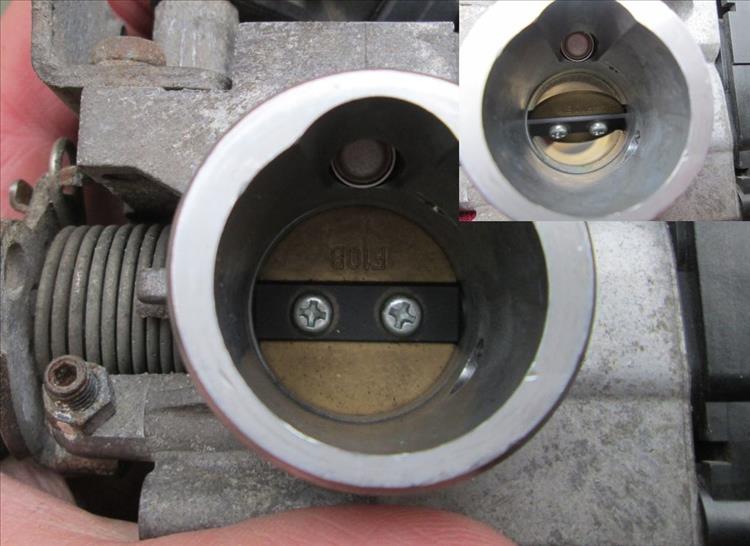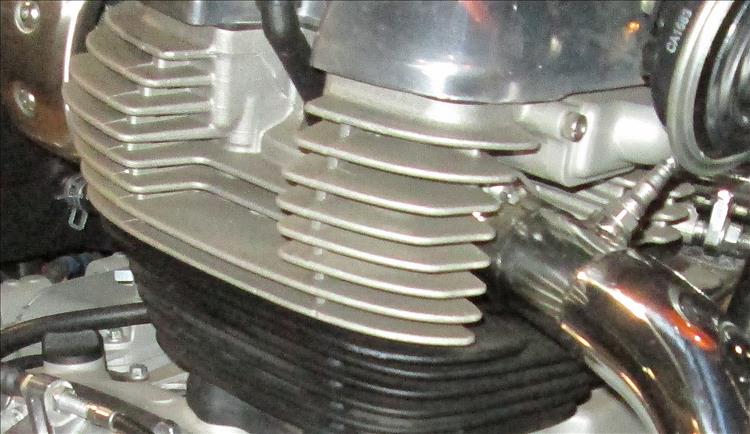Home
Ren's Biking Blog
Pumping Losses
Nerd Date - Friday, February 15, 2019
Rod stirred the hornet's nest with his post MPG - The Bike Or The Rider?. Some discussion followed about revs, capacity and rolling resistance. What I have not seen mentioned so far are pumping losses.
Pumping losses?
A 4 stroke engine is an air pump with 2 additional strokes. The noisy "thump thump thump" air compressors found in most small garages and workshops have a piston very much like the one found in a motorcycle engine. There'll be 2 valves too, an inlet and an outlet, much like a motorcycle engine.
As the piston falls it draws air in from the currently open inlet valve. At the bottom of the stroke the inlet closes and the outlet (exhaust?) opens. The piston rises pushing the air out and into the chamber. 2 strokes. A 4 stroke engine works exactly the same way but the valves remain closed for 2 strokes between the inlet and outlet, giving us compression and power. Throw in some fuel into the air and a spark and you have a 4 stroke motor.

Suck, blow, skip the squash and bang bit for a compressor.
Now, in your mind go back to the air compressor in the garage. Somewhere there's a hole where the air is sucked into the compressor's piston. Imagine then covering that inlet hole with your hand. Not only would the piston suck hard against your hand but the motor driving the piston would have to work a LOT harder to keep that piston turning against the vacuum created as the piston tries to draw in air.
This is what happens when you close the throttle on your motorcycle. It's not called a throttle for fun, you are quite literally strangling the breathing hole of your motor. Your revs fall NOT because you are putting less fuel in. Your revs fall because you are letting less air in, which coincidentally (or digitally) reduces fuel flow. You are not shutting off the "gas" as the Americans say, you're shutting off the air (which is a gas - go figure).

This valve is strangling the life giving air from your poor engine.
In this throttle closed position at tickover the engine is quietly working quite hard to overcome the vacuum created in the inlet tract and piston because the throttle is closed. We hear a nice soft tickover, inside the engine is fighting bitterly hard to use the tiny bit of fuel and air being dribbled into to it to keep itself turning over. Each and every revolution is a battle for survival.
When we open the throttle we allow the engine to breath fully once more. In a carb this causes the plunger to rise allowing in more fuel. On injected systems the computer notices the throttle position and increases the fuel flow rate. Now instead of fuel being wasted desperately trying to draw air in it can be used for forward propulsion as intended.
On a powerful motorcycle we rarely keep the throttle wide open for any length of time. Most of the time we are on a partial throttle, the more powerful the engine the more the throttle will be closed. This makes the engine less efficient. While most of the fuel is being used to push the motorcycle forwards a portion of the fuel is wasted trying to draw air in against the mostly closed throttle. On a small capacity motorcycle the throttle has to be open wider to achieve the same speed. Hence less energy is wasted pulling against the throttle.
Hence smaller engines are more efficient...? No?
What I have written above is all true. BUT.
If you're going to stand at the bar trying to look knowledgeable and state that your 125 is more efficient than your friend's 750 because of pumping losses then you're going to look silly. Pumping losses are a part, a small part of a much larger and complex system. Vehicle mass. Rolling resistance. Engine friction. Aerodynamics. Engine design. Final drive (transmission). Gearbox design. All this and more affect the motorcycle's ability to use fuel well. Then throw in riding style and you're stuffed.
If you wish to see an engine that is not restricted by it's throttle - look up how a diesel engine works. I said "... most of the fuel is being used to push the motorcycle forwards..." Look up engine efficiency and you'll realise this is not true and internal combustion engines are actually air heaters with the side effect of propulsion.

This is not an engine, it is a heater with a little rotational force left over.
If you'd like to advertise with Bikes And Travels contact ren@bikesandtravels.com
Reader's Comments
Pocketpete said :-
So if we take the 250inzuma and Sharon's sl250. They are both the same engine size but I would assume the inzuma is pretty damn heavy compared to Sharon's bike but sharon may be slightly more sporty tuned. Which will be more efficient.
18/02/2019 08:48:19 UTC
Ren - The Ed said :-
HA!!! Holy poop Pocketepete. IF IF IF it were purely down to pumping losses then as the Inazuma is heavier therefore the throttle is open wider then the Zuma would be more efficient. But this is nonsense. Because the throttle is open wider the Zuma is letting more air in. More air means more fuel. More fuel means less efficient.
My money would be on Sharon's being a little more efficient than the Zuma. Simply because there's less metal to get moving each time we leave the lights. BUT, and it's a big BUTT (and I cannot lie...) Sharon's engine is from a motocross bike. Power is everything, fuel is nothing in motocross.
Sharon often returns 90mpg. That seems amazing but bear in mind she only weighs about the same as the engine in my 500 and as she's small she offers very little wind resistance. I'd be curious to know what a 15 stone 6 footer would achieve.
18/02/2019 09:52:09 UTC
pocketpete said :-
So its very hard to compare even two similar size engine bikes. I do wonder when I looked at fuelly where people put up their mpg whats going on. CB500x's seem to range from 65 to nearly 100mpg. I suppose my bike with a slimeline 16stone 13lbs (down from 18 9lb despite the recent bacon butties) will be far more efficient if sharon was riding it.
Maybe that accounts for the sudden increase in mpg I have been getting. My bikes average has been firmly on 74.8mpg for as long as I can remember but now seems to be 76mpg.
Is that the reduction in mass or the service and tappets or both which has raised me to such heady heights or just slightly less traffic going to work at 5am instead of 6am.
Maybe we should introduce some some of bike handicapping system like they have in horse racing to even the mpg up a bit.
18/02/2019 11:10:55 UTC
Rod said :-
I think that we now all realize that many factors are involved in the fuel economy equation.
Pumping losses are one factor, and are felt when riding as engine braking.
What I do not understand is what "Sharon may be slightly more sporty tuned" has to do with pumping losses?
18/02/2019 21:28:53 UTC
Pocketpete said :-
Sharon's 'bike' mights be more sporty tuned was the missing word.
Damn phone
19/02/2019 04:58:55 UTC
Ren - The Ed¹ said :-
Haha!! I hadn't noticed Rod. I guess Sharon is sportily tuned. She's coming on for 50 now so some of the newness has worn off but she's still running better than many newer models.
19/02/2019 05:58:10 UTC
Sharon said :-
Haa haa I am sportily tuned. My answer to anything remotely scary on my bike is more revs. Flood across the road, tarmac ripped up is a hazard..answer accelerate get through hazard as quickly as possible. I think my flight response to a frightening experience is tuned to the max. It may not always be the wise move to chose revs over caution but now I realise it's not really my fault because by default I'm sportily tuned ??
19/02/2019 09:45:41 UTC
Snod said :-
You're talking of pumping losses but not mentioning that singles or twins that aren't 180 degrees will pump the air in their crankcases? Pfff half a job.. :P
For the record I'm averaging 84MPG on my 250SL and weigh 68kg but the MPG is likely down to the way I ride it. I did once manage 68MPG on a motorway run!
19/02/2019 21:41:31 UTC
Ren - The Ed¹ said :-
Yes Snod, quite true. Even a balanced 4 cylinder engine will lose the tiniest amount of power by pushing air from one side of the crankcase to the other each stroke. I suggest you write it up with diagrams and explanations so our dear bewildered readers can understand that which we speak!
I still think 84mpg is not bad going. 68kg? By eck I wish I was 68kg.
20/02/2019 08:11:49 UTC
Mr Maffs said :-
Efficiency is energy out / energy in and it is always < 1. If you could manage to convert all the heat energy available from a gallon of fuel into the same amount of power from your engine you'd have an efficiency of 1 (or 100%). I haven't done the maffs, but I guess you'd be doing well to get 50%, and the other 50% is wasted - heat, noise, pumping, friction, and energy pouring straight into and out of the exhaust pipe.
22/02/2019 18:09:21 UTC
Ren - The Ed¹ said :-
I know there was a massive fuss when Mercedes' F1 engine achieved 50% efficiency. Impressed? That was only in absolutely ideal situations along with regen from the turbo and braking and and and and etc etc etc. Car engine are lucky to get around 30%, some modern designs a little more in again ideal scenarios.
Much as I love a petrol (or diesel) engine the benefits of electric are plain to see.
22/02/2019 18:30:07 UTC
Name
Comment
Add a RELEVANT link (not required)
Upload an image (not required) -
Uploading...
Home
Ren's Biking Blog